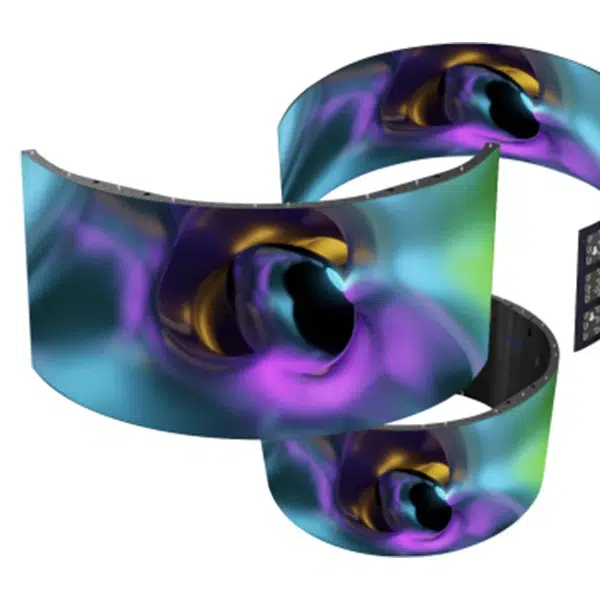Flexible LED Screen Ultra-High-Resolution
A new kind of ultrathin, superfast, low-power, high-resolution, flexible LED screen or curved LED screen may be in the works, according to research published today in Nature. These displays may incorporate some of the most advantageous aspects of existing display technologies, provided that the inevitable engineering challenges associated with bringing a product from the lab to the living room can be overcome.
Phase-change material used to create a flexible display.
Flexible LED screen with flaws are all around us. All of our Flexible LED screen, including those in our smartphones, laptops, televisions, watches, billboards, thermostats, and even glasses, have limitations: Most can’t be rolled up and tucked in your pocket, some can’t do rich colour, others can’t display a true black, and others ruthlessly drain your battery. However, a better option might be coming.
A new kind of ultrathin, superfast, low-power, high-resolution, flexible LED screen may be in the works, according to research published today in Nature. These curved LED screen may incorporate some of the most advantageous aspects of existing display technologies, provided that the inevitable engineering challenges associated with bringing a product from the lab to the living room can be overcome.
The brand-new displays function
Materials that are already commonplace, including the metal alloy that is currently used to store data on some CDs and DVDs. The ability of these materials to exist in two states is their primary characteristic. They can change their state by being shocked by heat, light, or electricity. Phase-change materials is what scientists refer to them for curved LED screen.
According to Alex Kolobov, a researcher at Japan’s Nanoelectronics Research Institute who was not involved in the new work, “It is really fascinating that phase-change materials, now widely used in optical and non volatile electronic memory devices, found a potentially new application in display technology.”
Similar to the electronic paper found in products like the Kindle reader from Amazon, a PCM display would function. Both are produced by slicing a material into two states—one lighter and one darker—and sandwiching it between two layers of transparent conductors. A viscous black oil containing tiny white titanium balls fills the interior of electronic paper. Running a current through a small section of the glass causes the reflective balls to be drawn through the ink and to the front, making the pixel white. You must pull pixels toward the back and run a current in the opposite direction to make them black .
A substance made of germanium, antimony, and tellurium—heavier chemical cousins of silicon—serves as the inner material in PCM displays. The ordered crystal and the disordered glass that make up this substance’s two states, known as GST, are actually two different phases of matter. You can change between them by melting a small column with a current pulse. You can either gently cool it to make crystal or quickly cool it to make glass. More than a million times per second can be accomplished in this cycle.
In terms of consumer goods, that speed could be very advantageous. The refresh rate on a PCM display would be fast enough to play movies, whereas scrolling on a Kindle can be agonising due to the curved LED screen only refreshing once every second.
In order to create the new displays, a team of researchers led by Oxford University’s Harish Bhaskaran used a 35-year-old machine created by the semiconductor industry to lay down three layers: a few nanometers of conducting glass, GST, and a subsequent layer of conducting glass. Then, drawing images on the surface with current from an atomic force microscope’s tip, they drew everything from fleas to vintage cars to a Japanese print of a tidal wave. Each image is a fraction of a human hair wide.
By altering the way light reflects off of a PCM display’s layers, the researchers demonstrated that colour can be controlled. Because the two states of GST diffract light in different ways, each pixel can be one of two colours. The researchers alter the thickness of the sandwich’s outer conducting layers to produce a wider range of hues, such as azure blue and popsicle pink. The team has so far only produced two-tone images, using different colours for the two tones, but according to Bhaskaran, it should be possible to develop a full-color PCM display.
They used a sheet of mylar they had borrowed from the shop next door, cleaned it up, added GST, and zapped in a tiny image of a neoclassical dome to create a flexible LED screen.
A PCM display could be transformed into a programmable contact lens with a flexible, ultra-high resolution of flexible LED screen, just like Apple’s retina-sized Retina Display.
Years of work and hundreds of millions of dollars will be needed to turn this technology into products. According to Raymond Soneira, president of the display analytics company DisplayMate, even if a big company signs up, they will have their work cut out for them. According to Soneira, “the eye is very critical, and existing display technologies already perform very well.” He claims that as of right now, PCM displays have about ten times less contrast than contemporary Flexible LED screen. Thin films’ colours can also appear washed out. Although the researchers were able to control a single pixel at a time, a grid of millions of pixels will be required to create a device that people could actually use.
Bhaskaran and his coworkers remain upbeat, though. There are many well-known techniques to try to improve this initial draught because the electronics industry has a lot of experience with all the components.



